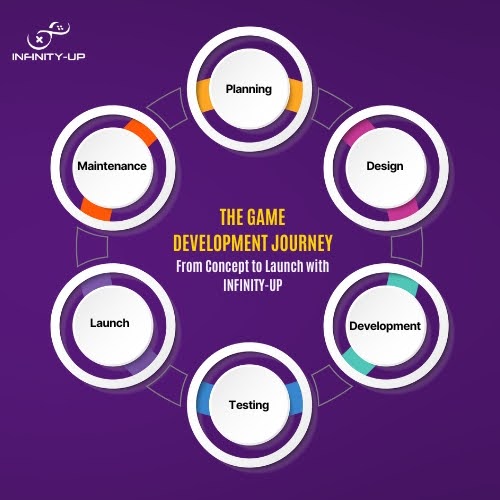Game Development Process
Game Development Process
Making a video game is like building a world! You start with a cool idea, then plan it out carefully, and finally bring it to life with art, sound, and code. It’s a fun mix of creativity and problem-solving!
Here are all the steps that INFINITY-UP, the top game development company, is following in an organized and efficient way.

Planning
The first phase of game development is the conceptualization of the game idea. This is where the creative process starts. Developers brainstorm and explore concepts, themes, and gameplay. The goal is to come up with a unique and compelling idea that forms the foundation of the game.
At INFINITY-UP, we start strong by planning every game. This means figuring out what the game is, how long it will take to make it, who and what we’ll need, and how much it will cost. It can take weeks or a year, depending on how complex the game is.
Design
Game Designers use long documents to plan their games. These documents take a long time to make. Planning must figure out how players will control the game. This includes moving and fighting.
At INFINITY-UP, planning keeps things smooth. We skip super-long documents because things can change during development. That’s why we use shorter “Game Design Documents.” These 1-2-page summaries keep the core game vision clear while giving us room to adapt as we build.
The Manifest named the INFINITY-UP team one of the most-reviewed graphic design agencies.
Development
Development is the heart of the game creation process! It’s where the ideas from pre-production turn into the actual playable experience.
This is how the INFINITY-UP development team tackles projects:
Bringing the game to life:
Here, programmers, artists, and sound designers work together. They build the game. Programmers write code to create the core mechanics. This includes AI behavior and game logic. Artists create the visuals, from characters and environments to animations and user interfaces. Sound designers craft the audio experience, including sound effects, music, and dialogue.
Collaboration is Key:
Different teams constantly communicate and collaborate during development. They might see areas where the plan needs adjustments. They would base these adjustments on how things go.
Iterative Process:
Development is rarely a straight line. Teams often create playable prototypes to test mechanics and get feedback. They use this feedback to iterate and refine the game. They make adjustments until it reaches its final form.
Long Haul:
Development can be the longest stage of game creation. It takes months or even years for complex titles. It requires a lot of work, problem-solving, and adaptation from the development team.
Developers have completed the core game development. Limits caused us to make essential cuts. Then, it’s the testing phase that begins.
Testing
Testing, known as quality assurance (QA), is a crucial stage in game development. It involves identifying and fixing issues to ensure a polished final product.
INFINITY-UP ensures exceptional quality through a comprehensive testing strategy. The developer does detailed unit testing. Then, there is extensive playtesting with internal and external testers. This teamwork refines game balance. It finds and fixes bugs. And it ensures a polished final product.
Launch
The launch process is the final step in game development. All the hard work finally pays off when we release the game to the public.
Before the launch, INFINITY-UP’s marketing team works to create excitement and anticipation. They do this by releasing trailers. They also set up a website or social media pages. Sometimes, they offer early access or beta tests to get feedback and build a community.
Once we launch the game, it’s a great time to collect data on how players are interacting with it. Sales numbers, player engagement, and feedback can show what worked. They show developers what worked well. Future games could also benefit from the improvements shown by it.
Maintenance
In game development, maintenance is an ongoing process. It keeps the game running well. Engaging players after it’s launched is also important.
That’s why the INFINITY-UP team includes these steps:
Bug Fixing:
Identifying and fixing bugs to ensure a stable experience.
Content Updates:
Adding new levels, characters, or items to keep players interested.
Performance Optimization:
Updating the game to run well on new software and hardware.
Live Events:
We’ve been hosting events or challenges to keep players engaged.
Community Management:
Interacting with players and addressing their concerns.
Maintenance helps ensure a positive player experience and can extend the game’s life.
The Best Programming Languages for Game Development

The developers of INFINITY-UP use the best programming language. It aligns with the system’s style and needs.
C++
C++ is a powerful programming language. It can create big, complex applications. This makes it a good choice for both small and large development teams. C++ also works well with many popular game development tools. This can save developers time and effort. In short, developers can use C++ to create a wide variety of software because it is a versatile language.
C#
C# is a robust language, like C++, with a focus on usability. Imagine giving instructions to a friend. C# makes things clear and easy to understand. It’s great for making many kinds of software. These range from mobile apps to games. It partners with a popular platform,.NET.
Java
Game developers love Java. It is a top choice for making mobile games on Android. It’s like having a giant toolbox filled with helpful things to build your game. This along with Java’s ease of use, makes it a popular choice for bringing game ideas to life.
JavaScript
JavaScript excels at crafting web and mobile games. Its alignment matches the development requirements of these gaming sectors exactly.
Objective-C
Objective-C is a programming language. It’s like C++ but simpler. It’s designed for building Apple applications, including the iPhone, iPad, and Mac. It combines the power of C with object-oriented features.
TypeScript
TypeScript is like JavaScript. It has a special power to define types for your code. This helps catch errors early and makes large projects easier to manage.
Best Practices for Game Development Process at INFINITY-UP
INFINITY-UP is an award-winning game development company. Manifest and Clutch gave it the awards. It crafts custom game experiences and gamified solutions from idea to launch.
Making games like INFINITY-UP needs good planning, teamwork, and paying close attention to every detail. Following the best methods helps the INFINITY-UP developers work better. It also makes their work smoother. It allows them to produce superior games.

Precise Communication:
Set up good communication within the game development team. It’s to make sure everyone is on the same page. This will foster collaboration and cut misunderstandings.
Progressive Development:
Embrace agile methods in the game development process. Break the project into manageable parts. This will allow for flexibility, adaptability, and quick feedback loops.
Continuous Testing:
is crucial. It happens during game development. It gathers player feedback and identifies areas to improve. Playtesting helps refine gameplay mechanics, balance difficulty, and enhance the player experience.
Source Control:
Install a robust version control system for the game development process. It’s going to manage code, assets, and changes well. This ensures that all team members are working on the latest version of the game.
Documentation:
Maintain clear and up-to-date documentation during game development. This includes the game design document, coding standards, asset pipelines, and technical specifications. This documentation acts as a reference and promotes consistency throughout the development process.
Quality Assurance:
Focus on quality assurance testing in the game development process. This identifies and addresses bugs, glitches, and usability issues. Rigorous testing helps ensure a polished and bug-free game.
Repetitive Development:
It’s about a repetitive process. It allows for continuous improvement. They base their decisions on feedback and changing needs. Iteration enables developers to refine and enhance the game over time.
Conclusion
Game development is a multifaceted journey requiring creativity, technical skill, and careful planning. Following best practices, such as clear communication and agile development, improves workflow. So does thorough playtesting and rigorous quality assurance. These practices ensure the creation of great gaming experiences. Embracing an iterative approach is crucial. Keeping good documentation is also key. Both are vital for the success of game projects.
If you have no experience in coding, game art, or management, but if you have a great idea for a game, consider working with INFINITY-UP. We can make your concept a reality.

